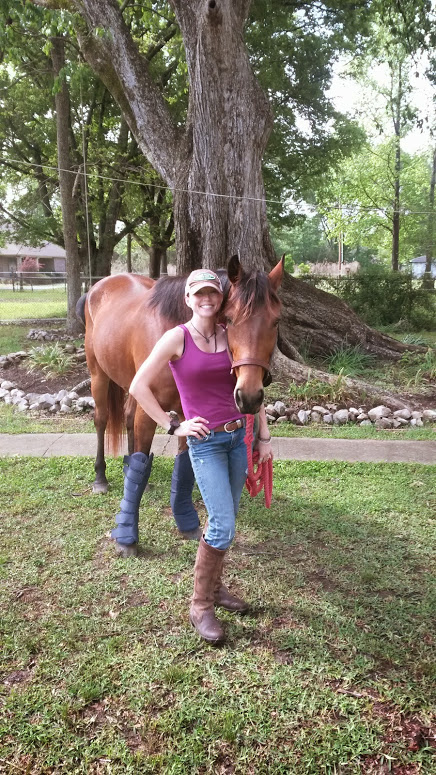Rehabilitation Both in and Out of the Saddle
by Emily Beasley
Growing up, I absolutely idolized my dad. To this day I still envision him as one of those Wild West types. In other words, a real cowboy, tough as nails. He was riding bulls, training horses and calf roping. As a result, he experienced broken bones, several injuries and numerous scars. I’ll never forget the day he came in with a needle and thread and asked for my help sewing up a 3-inch gash in his hand. The worst injury happened about ten years ago when he lost three fingers in a roping accident. The rehabilitation process was extremely difficult and painful but, a true cowboy, he stuck with it.

I have a horse that reminds me of my dad in many ways. He’s as tough as nails, with scars that indicate a much different life before he came to me. We’re currently in the middle of a rehab program to work through some of those old scars and injuries. Sometimes I affectionately call him The Rehab Horse. It’s difficult and sometimes painful, for the both of us, as we struggle through muscular imbalances and tight muscles, work at rebuilding weak muscles and practice moving in ways that are completely new to him. He’s 14, yet our training sessions often resemble what would happen if he were a baby just learning. Though not as extreme, it reminds me of my dad relearning to use his hand and fingers.
Many of us have muscular imbalances from old injuries, but sometimes they are simply due to everyday life and ingrained habits. For example, chances are that if you sit at a desk you will have tight chest muscles and weakened back muscles. Your hips are also probably very tight. You may have rounded shoulders and weaker core muscles. If your job requires you to spend all day on your feet you’ll have different muscular imbalances and weakness. The point is we all have to re-learn how to use our bodies when we’re in the saddle. To achieve success, we will also need to relearn how to use our bodies out of the saddle. It’s not always easy and can even be painful, but the results are worth it! I challenge you to start your own rehab program and retrain your body to move with balance and ease. To do so, consider the following:
Realistically assess what your strengths and weakness are out of the saddle. Does your right leg do all the work when you walk up stairs? Do you always reach for things with the same hand? Do you notice your shoulders rounding more as your day progresses? Start to notice your posture and how you move your body during your day-to-day activities.
The next time you ride pay attention to how you move your body while mounted. Is your right leg doing all of the work? Is your dominant hand working more than your opposite hand? Are your shoulders rounded and do you often catch yourself looking down? Notice your posture and how you’re moving your body in the saddle. There is a significant chance it will mirror how you move in everyday life.
Do a little research and start your own retraining program, or seek out the help of a professional. Look at ways you can strengthen your right leg. Start reaching for things with your non-dominant hand. Buy a stability ball and replace your office chair (I promise this will do wonders for your posture and core strength).Take breaks throughout the work day to practice all of the movements you are trying to relearn.
Changing the way you move your body is not easy; I struggle with my own posture daily. It’s not comfortable for me to sit correctly—it’s painful and difficult. Retraining the way I carry myself during day-to-day activities is in no way comparable to rehabilitating from a significant injury. However, daily practices can lead to long-term health challenges in the future, or health and physical strength. Lastly, the immediate improvement I notice in my horse and riding makes it all worth it.
Have a question about rider wellness for Emily? Email editor@nwhorsesource.com.
Published in October 2015 Issue

Emily is the owner of ATF Wellness and the creator of Bootcamp4Breeches: Functional Fitness for Equestrians. She coordinates the Health & Physical Education teacher education program at Louisiana State University, is past president of the Louisiana Association for Health, Physical Education, Recreation and Dance, teaches Yoga classes, and researches how women of all ages can develop a positive physical self-concept. She spends her free time eventing with her OTTB, Titan, and TB/Cleveland Bay cross, Bean, in Baker, LA where she and her husband share a small farm with four dogs, three cats, and three horses. You can reach her via email at drb@atfwell.com; follow her on Twitter @DrBLovesPE; or like her Facebook page, Bootcamp4Breeches: Fitness Training and Wellness Consulting.

